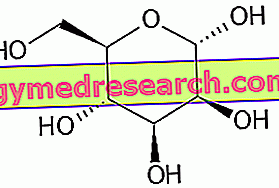See also: thyme - gland - Thyme and thyme essential oil
Thymus vulgaris L.
Fam. Lamiaceae (Labiatae)
Fr.Thym
Ing.Thyme
Sp. Tomillo comun
Ted.Thymian
COMMON NAMES : Tummu, Tumetti (Lig.) Timi (Piem) Erba Salterella, Timm (Lomb) Peerel (Fri) Temu, Tem (Em) Peparello (Mar) Amorino (Umb) Tuma (Abr) Tumu (Pug) Peperna (Camp ) Serapodda (Bas) Timu, Tumineddu (Sic) Tumbu, Arrigamu (Sard)
Description
The common thyme is a high suffrutice 20-60 cm, with bushy habit and branched stems that tend to lignify after 4-5 years of life.

Leaves: the thymus has opposite leaves, dotted, briefly petiolate, with the rounded edge downwards, almost sessile, lanceolate, gray-green, lighter on the lower side due to the presence of hairs. There are abundant protector hairs, including the typical knee-folded ones and sessile brownish-yellow secretory hairs with heads of 12 cells
Roots: The root system is collated and has a woody consistency.
Flowers: The flowers are small, tubular, red-violet, grouped in spikes at the axil of the leaves. They have a velvety calyx, tubular in shape and ends in two lobes, the corolla is bilabiata, with the upper lip straight and marginalized, the lower three-lobed, 4 stamina didinami. Flowering occurs from June to September.
Fruit: it is a tetrachenium consisting of ovoid cocci
Taste: The leaves of the thyme have a bitter taste and an intense aroma of camphor.
Areal
Thyme is native to the western Mediterranean region. It grows spontaneously throughout the Mediterranean area up to 1500 m. It prefers calcareous and well-drained soils. It grows well in sunny places and does not tolerate wet and cold winters.
It is grown in France, Spain, Greece, Portugal and the United States.
Culture
Duration of cultivation: the cultivation of the thyme lasts 3-4 years as the plant tends to lignify. In colder climates it behaves as an annual, as it hardly overcomes the rigors of winter. In these environments, in the autumn, mulching is used as a preventive method.
Sowing: the plant is run using cuttings in spring or by dividing the head. The sowing of the thyme, which can be carried out directly at full field using 5-6 kg / ha of seed, is not a customary practice due to the small size of the seeds, which does not allow a uniform culture.
It is preferable to sow seeds in seedbeds in March, using 1 g of seeds per m² of seedbed; an area of 50-60 m² is sufficient to produce the plants needed for one hectare of cultivation.
The next transplant is performed in autumn, in milder climates, or in the early spring, in the colder ones. 5-7 cm high seedlings are used.
The layout of the maps is at 50-60 spaced rows. The optimum crop density should be around 10 plants per m².
Requirements: the thyme is considered an undemanding plant in terms of fertilizers.
Adversity: of a cryptogamic nature: Alternaria oleracea Milb, which damages the fruits, Puccinia menthae Pers, and Aecidium thymi Fuck, which attack the leaves.
Harmful insects: we remember some leaf miners including the larvae of a moth (Tortrix pronubana Hb.) And a nematode (Meloidogynehapla Chitwood) which damages the underground apparatus.
Weeds: The crop is subject to being parasitized by Cuscuta epithymum (L.).
Drugs: these are the flowering tops, and the leaves from which the thyme essential oil is extracted. The typical smell is strong and aromatic, due to the presence of thymol, the taste is slightly spicy. It also contains carvacrol, p-cymene, borneol and pinene. Conservation: the tops are dried in the shade in a well-ventilated place on sheets so as to collect the parts that come off during drying.
Harvest and yield: Thyme is harvested at the time of full flowering if the product is destined for distillation by mowing at a height of 5-10 cm from the ground, so as to remove as much as possible the richest basal leaves in essential oil; while, if the crop is aimed at herbal use, it is preferable to intervene at the beginning of flowering in June-July, cutting the floral stems at 5-10 cm, below the flowers. A good crop can provide an annual yield of 5-6 t / ha of fresh product. The dry yield is around 35%. The essential oil yield of the whole fresh plant is 0.5-0.8%. The thymus reaches its maximum production in the third year of planting.
uses
Herbal and Phytotherapy: the infusion is a remedy against asthma, hay fever and all allergies; in small doses it also serves for intestinal fermentations and catarrhal affections of the respiratory system. Decoctions and infusions are used to cleanse small sores and wounds and to disinfect the oral cavity. In fact, it has bactericidal activity due to the phenolic, thymol and carvacrol components that together make up 25 to 40% of the essence
Dietetic: the thyme is an aromatic plant of all respect, thanks to the digestive and carminative properties it goes well with meat, fish, sauces, vegetables, liqueurs and vinegar and is used to prepare pizzas together with sesame and lemon. Herbal teas and thyme syrups stimulate the appetite and promote good liver function.
Cosmetic: energetic anti-fatigue action on the face, due to the presence of mucilage and stimulation of the superficial circulation. Thyme oil can also cause allergies in cosmetic preparations.



